Twisty mountain passes, stunning vistas and road-going Bison – it can only be the Rockies by Harley.
This adventure was born two and a half years ago on the icy, windswept plains of Yellowstone National Park. It was -120C and the howling wind whipping a layer of snow airborne so that it resembled a dense low fog that blurred the surface of the trail ahead.
I was perched atop a blissfully heated snowmobile saddle, hands on heated grips and the rest of me swaddled into an arctic jumpsuit that was clearly the inspiration for the Michelin Man.

It was when a hunkering old bull bison rumbled past, this 2000lb beast standing 6ft tall at the shoulder, that I knew I was utterly hooked on Yellowstone and would return in better weather, on a bike. And I did, riding 2800 miles in eight days over mountain passes and encountering even more bison in a ramble through the American West.
Enjoy everything MSL by reading the monthly magazine, Subscribe here.
I’d flown into Rapid City and picked up a shiny blue Harley Road Glide Special from the team at Black Davidson before striking out on a journey that would take me in a loop through the iconic Black Hills in South Dakota before heading west into Yellowstone. Eventually I would be rolling into northern Montana and Glacier National Park, the jewel in the crown of the Rocky Mountains. It was my first time on a Road Glide, which felt familiar, with a similar stance to my own 2014 Road King, but I was truly impressed by the space afforded a tall rider like myself at 6ft 4in by the sloping front fairing and dash.

A few days later, I’d completed my Black Hills loop, before heading into Yellowstone. Riding west out of Cody on Highway 14, I had a quick stop to add much needed layers in the just below zero temperatures and enjoy the gorgeous sunrise over the cliffs of Buffalo Bill Reservoir. Yellowstone was the world’s first national park, and is still well populated with bison, grizzly and black bears, elk, moose, coyote, and wolves. Cutthroat trout have anglers lining the creeks and rivers, and large birds of prey soar overhead, include osprey and bald eagle. Dense forests of lodgepole pine blanketed the landscape as I headed for Yellowstone Lake, the largest high altitude lake in North America.
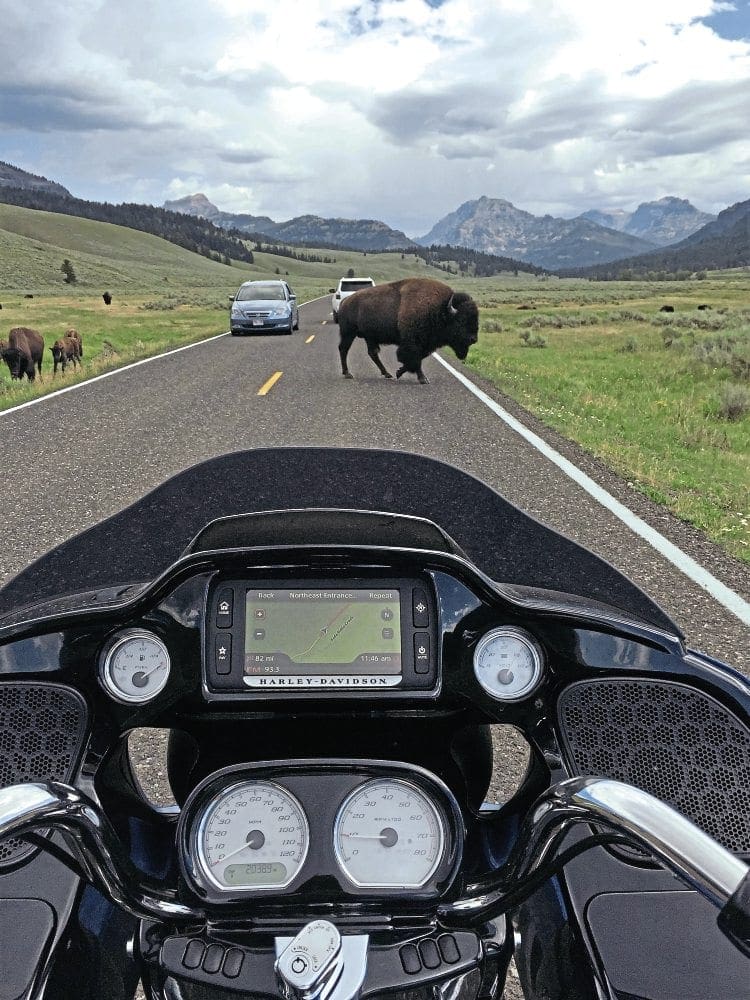
It wasn’t long after I stopped to enjoy the views at the lake that the fun really started and a welcoming committee of bisons decided to join me on the road. In summer when the cows are in heat, the mountainous bulls are sent into a slathering, hormone-driven frenzy. One took a sand bath on the roadside, spraying a thick halo of dust into the air before proceeding to spin on the spot, seeking out an imaginary threat, bucking and kicking out like a prized rodeo bull. The fact that these antics unfolded a mere 10 paces away was not lost on me, and I could only hope that the monstrous beast didn’t take a disliking to Aussies on bright blue bikes.
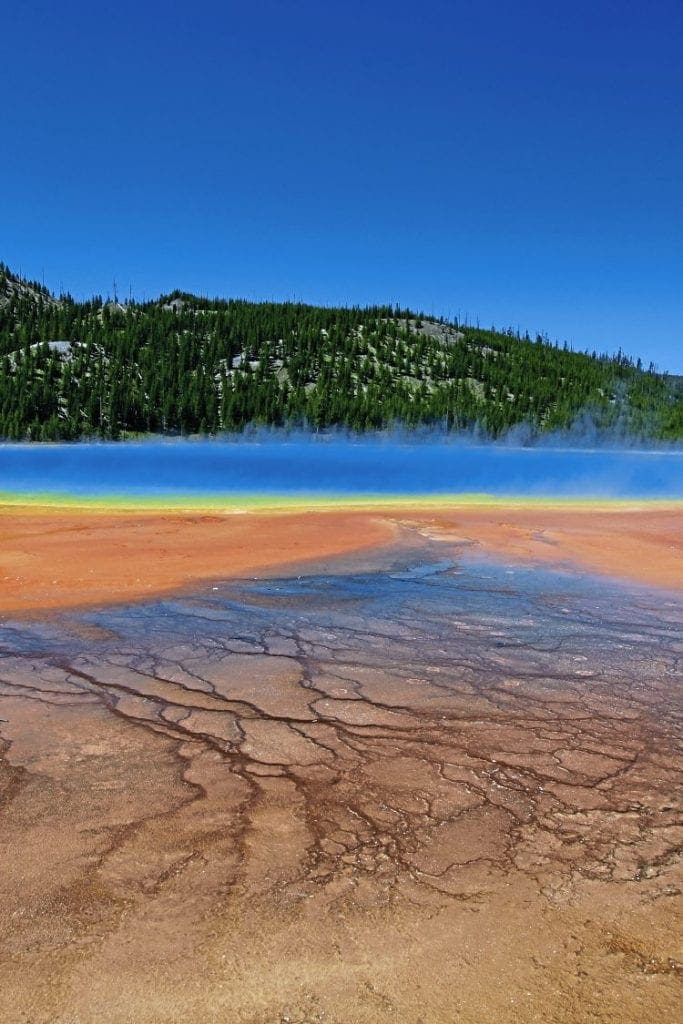
I finally cleared the traffic jam brought on by the herd and took off for a wondrous roll through the park to Canyon Village and then on to the Grand Canyon of the Yellowstone, This is where the raging snowmelt-fed Yellowstone river cascades over the spectacular lower falls (94m), and then up into Tower-Roosevelt and the stunning Tower Falls where Tower Creek topples from the volcanic pinnacles to eventually join the Yellowstone River around 40m below. Rolling out in a loop on the west side of the park took me to Grand Prismatic Spring and the extraordinary colour palate of the thermal pools that flash a brilliant turquoise blue and vibrant orange in the breaks through the billowing steam that erupts from the super-heated pools.
Rolling north toward the Lamar Valley takes you past entire grassy slopes that are carpeted with blooming yellow balsam root and bursts of blue lupine, splashes of colour against the lodgepoles as I looked south from Dunraven Pass at 2700m. The roads themselves are well kept and the sweeping turns on eastern Grand Loop Rd will have you itching to pick up speed, but with the recent bison encounter still on my mind, I found that it was easy to be patient and sit back, keep to the speed limit and enjoy the view.
TWISTS & SWITCHBACKS
Next day, after staying in a delightful little hotel on the edge of the park, I was on the road early again to enjoy a glorious sunrise from Mount Washburn. There was a half-mile queue of traffic waiting for the park gates to open at 9am, but I had to get going, with a 550-mile ride up to Whitefish, Montana.

This started with a fabulous run along the twisting Highway 191 that pokes you back into the park in short bursts before spilling out onto the hot plains and valleys of central Montana and eventually past the gorgeous Flathead Lake and on to the colourful little town of Whitefish, my springboard for the next big ticket item on the tour, the incredible Glacier National Park.
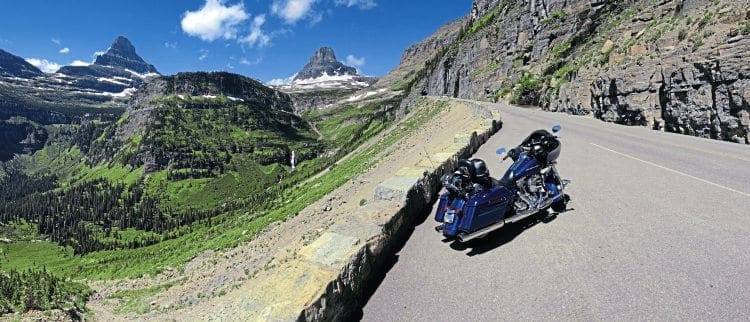
Riding across the aptly named Sawtooth Mountains was one of the best days I’ve ever enjoyed on two wheels. Setting out early on the cloud-draped Highway 2 across the southern border of Glacier National Park, I was soon sweeping along the Looking Glass Hill Road that borders the Blackfeet Indian Reservation. The extraordinary tarmac twists and turns like you would expect from any top flight mountain pass but it’s as if thawing permafrost and brutal winter conditions have conspired to generate rolling benches and folds in the asphalt that will leave you holding on tight and shouting for more.
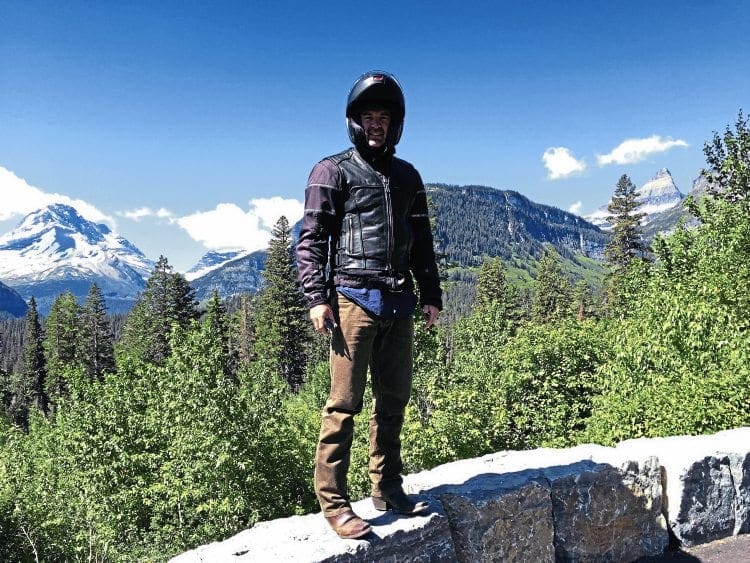
If the road weren’t enough to keep you wired, try having a wasp shoot down your shirt-front as you attempt to navigate this kicking monster. The first sting had me wondering who shot me, on the second sting I let out a few choice words, which turned into a tirade during the third. The fourth had me grasping at my jacket and trying to catch the bugger who was sending firebolts of pain through my chest.
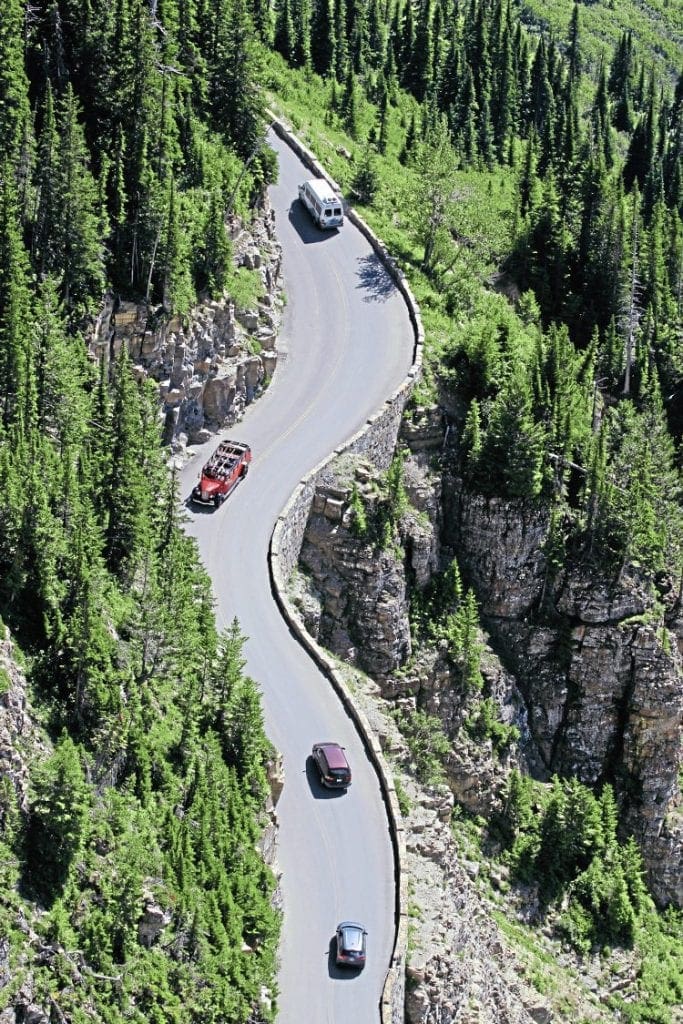
Jerking to a stop as quickly as the roadside would allow, I had layers ripped off one after the other in a desperate pantomime as the tirade continued, and it wasn’t until the offending critter was extracted and the damage assessed, standing on the roadside in nothing but my riding pants that I realized there was a car parked just ahead of me, no doubt wondering how to best escape the crazed lunatic who had invaded their view of the mountains.
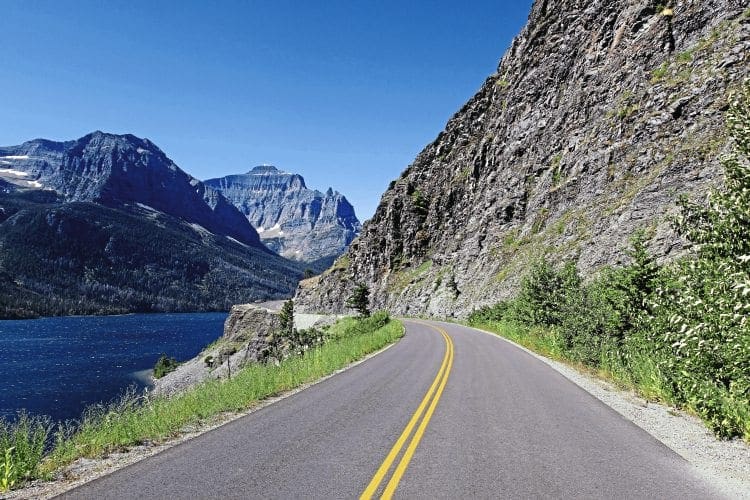
It’s difficult to articulate the incredible splendour of Glacier National Park, the so-called jewel in the crown of the continent’s ecosystem. It’s home to a staggering array of carnivores that includes grizzlies, wolves, mountain lions and lynx, plus deer, elk, mountain goats, bighorn sheep, and 250 species of birds. Then there are the staggering vistas of mountainsides, glaciers, lakes and U-shaped glacial valleys giving an unrelenting assault on the senses. Opened in 1933 after 20 years of construction, the Going-to-the-Sun Road seems to fight against the topography in a clawing, scratching dogfight of sharp curves, switchbacks, lurching bridges and precarious gradients that propel you across the very spine of the Continental Divide. Logan Pass Visitor Center provides a perfect launch for a hike through the gorgeous glades and snowdrifts to Hidden Lake, and then over to the Highline trail, a narrow path suspended above the roadside that offers spectacular views of the mountains, with marmots, squirrels and mountain goats all putting in an appearance.
INTO THE BIGHORNS
Rolling north out of Whitefish offered another day of asphalt delight, in a 550-mile loop out to Eureka and the remote Lake Koocanusa Scenic Byway, then down into the gorgeous back-roads of the Kootenai National Forest and eventually to Livingston. The penultimate day saw me heading south along the meandering Highways 540 and 89, whisking me past elk herds and back into Yellowstone, which cleared the last of the sleep from my slightly addled brain after almost 2000 miles in the mountains. The timeless Lamar Valley had me once again among the bison herds, the strutting bulls charging all potential competitors, sending calves scampering for cover. The incredible part of getting so close to these wondrous animals is the striking smell of sage that accompanies them in a wafting perfume from the abundant wild sage-brush they plough through during their rambles across the valley.
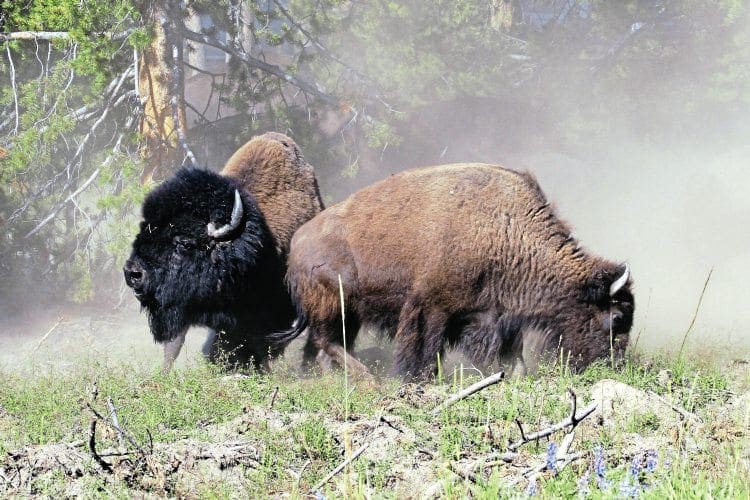
Saying goodbye to Yellowstone via the northeast entrance, a sense of sadness was soon replaced by the sheer excitement of the Beartooth Scenic Byway that strikes east out of the park. The Beartooth finesses the landscape with mountain-hugging curves that resemble the discarded rope of some mighty god, contorting and folding upon itself, almost melting into the landscape. Wonderfully engineered and maintained, the road surface and friendly camber lend themselves to a thrilling weave above the treeline in a series of sweepers and tight switchbacks that take you up onto the high alpine plateau before plunging you in a precarious descent down over 600m to Rock Creek below. Views, landscapes and thrilling mountain riding – this road has it all.
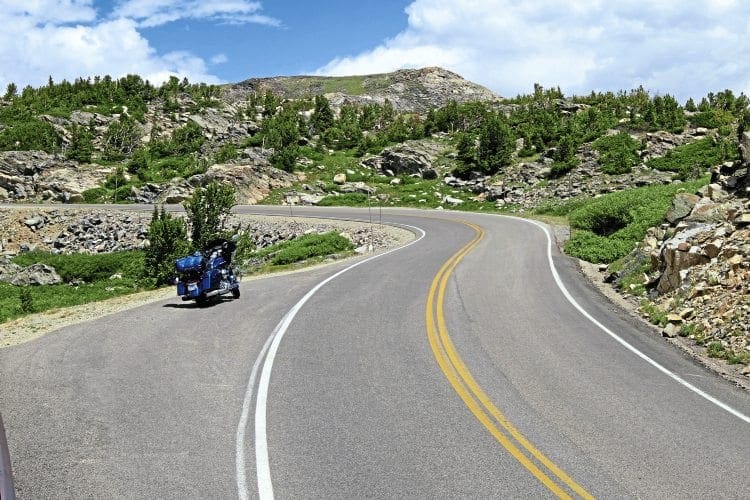
Spilling out onto the Polecat Bench and searing 35 degree temperatures in the lowlands, I was eventually climbing back east into the northern reach of the Bighorn Mountains for a rare but welcome night with no mobile phone or internet coverage at Burgess Junction. I was up early and shooting through the curves on the brilliant east face of the Bighorns on the eighth and final day of the trip that would end back in Rapid City to deliver the bike unscathed, except for some noticeably worn treads.
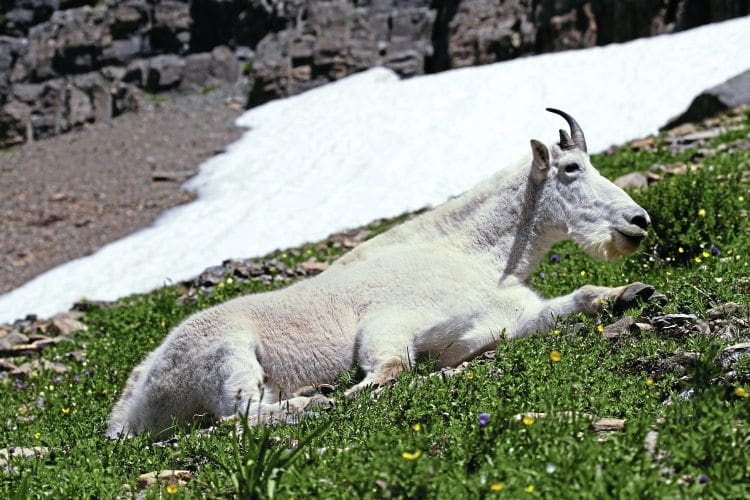
All good things must come to an end, and so too my 2800-mile loop from the sea of grass of the Black Hills in South Dakota, west into the volcanic wonderland of Yellowstone National Park and eventually into northern Montana and the Glacier National Park. Brimming with ideas on improvements, more side trips and escapades to pack into the route, I’ll be sure to come back next summer for another heady dose of the rarefied air and Rocky Mountain adventure.
Words & photography: Christian Noll
[googlemaps https://www.google.com/maps/d/embed?mid=10ArEC2OKxbCexcOeH_No8jg-4×8&hl=en&w=640&h=480]






